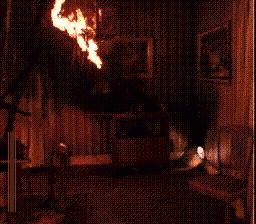You can trust VideoGamer. Our team of gaming experts spend hours testing and reviewing the latest games, to ensure you're reading the most comprehensive guide possible. Rest assured, all imagery and advice is unique and original. Check out how we test and review games here
Ico, Rez, God of War. All lauded by critics – all failed to set tills alight. An hour immersed in Quantic Dream’s compelling genre-defying horror is all we need to make a confident prediction: Fahrenheit will suffer the same fate as those aforementioned standard bearers.
Fahrenheit is unclassifiable. But, since society demands structure, Pro-G will humbly attempt to comply. Fahrenheit is like playing an interactive point ‘n’ click (with no pointing and clicking) version of 24 fused with an episode of the X-Files, a dab of Resident Evil, a twist of The Matrix, a hint of Track and Field (yes… Track and Field), a sprinkle of intense gameshow ‘answer with the buzzer’ madness, all topped off with the faintest whisper of a murder mystery story-based anti-hero psychological thriller. And breathe.
But first let’s discuss the premise. Set in 2009 New York, normally wrapped-up-warm citizens are starting to worry about a particularly cold wave that’s swept the city. Things are grim, and the forecast is even grimmer. Cue Lucas Kane, who’s drinking alone in a diner, away from the bitter cold. We watch him suddenly stand up, as if in a trance, and walk to the bathroom. With a knife he carves a demonic looking symbol in his forearm. A fellow diner enters, and Kane stabs him to death, all the while visions of a little girl reaching for help flash before our eyes. Kane comes to, looks at the scene before him, the blood on the cold floor, his hands and his clothes, and he realises what he’s done. He realises he is a murderer, but he cannot understand why. Cue you, the gamer. What are you going to do?
Which brings us nicely onto the interactive point ‘n’ click bit. There’s no cursor on screen at all, which is why it isn’t really point ‘n’ click at all, but it’s the best description for a totally unique and intuitive control system that, while it may take five minutes to wrap your thumbs around, it fuses with your brain like some electronic version of the Vulcan mind meld. Everything in Fahrenheit is controlled with the analogue buttons. When interactive bits of the environment are within range the option to move an analogue in a particular direction will determine your character’s actions.
So, we start moving Kane around. We approach the main mirror. An option presents itself at the top of the screen and we move the analogue. Kane starts to wash his hands of the blood his innocent victim so inconveniently splurged when being gouged by the knife. We are now trying to get away with it. We move towards a urinal. Seems like Kane needs to take a leak. A simple push of the analogue indulges our troubled friend. What about the body? We move it into a cubicle. The blood on the floor? We start to mop it up. All of a sudden we feel quite callous. Fahrenheit, quite brilliantly, is simply playing on gamer instincts.
Then we come to 24. As you try to work events out in your head, a cut-out of the diner bar fills half the screen, showing a cop about to walk into the toilet. This is happening in real time. What are you gonna do? Will you head for the window? Will you walk out of the toilet and leave as normally as possible? We decide to leave as we see the cop moving towards the restroom in the box-out on the right of the screen. We cross his path, the cop enters the toilet. We head for the door, the waitress screams for us to pay the bill – we run for it, desperate for the cold, harsh New York night to envelope us.
This opening scene demonstrates the thrust of Fahrenheit’s dynamic. Forget all those control methods you knew as a veteran of a thousand survival horrors and a million story adventures. In Fahrenheit time is always running out, and the game reacts to the instinctive decisions you make. At no point do you feel as if the game is making those decisions for you, which is, on top of all those other beautifully unique things it presents, why Fahrenheit looks like a must have for the thinking gamer.
In another twist to the traditional story based format, after you leave the scene of the crime as the murderer, you then assume the role of the cop assigned to catch you. Detective Carla Valenti is a J-Lo look-a-like cynical cop who’s tired of the beat. Your ability to cover your tracks in the previous scene affects your success in this one. For now, you and your partner Detective Tyler Miles are on interrogation duty. We control Carla first, and move to speak to the cop who discovered the body in the toilet.
Remember those dialogue trees in old Lucas Art’s adventure games? There was never any time pressure to get a decision out of the gamer quickly. Fahrenheit tears up the rulebook and starts writing its own, which is where we come to the intense gameshow ‘answer with the buzzer’ definition we gave earlier. Your response choices are displayed at the top of the screen, and a bar moves across the choices – you have to move the analogue when the bar is under the response you want. Wait for the bar to expire, and the game automatically chooses the worst case scenario response from the list. It’s an intense experience, and reinforces the instinct angle the developers are trying to achieve.
We switch from Carla to Tyler, and make our way to the juke-box. We blast some completely inappropriate 70s disco as the cop and waitress are trying to rid the image of a bloody corpse from their minds. Carla, who we discover is Tyler’s girlfriend, gives us a scowl to end all scowls. It’s these kind of touches, wholly unnecessary to the advancement of the plot, that make Fahrenheit such an interesting world to make decisions in.
We sample another scene (the interactive movie feel is further emphasised by the game being divided up into acts, rather than levels), which takes place in a New York park. As Kane, you seek out your priest brother for guidance, having committed a murder without knowing why, on the run from the cops and generally having your morals shot to pieces. This scene really shows off the unique beauty of Fahrenheit. Everything, I’m told by the PR, is motion captured. The whole park is covered in snow, and snow continues to fall. A man and woman are sitting on a bench, and children are playing in the snow, all fully motion captured in digitised glory. It looks like a scene from Fargo, and, quite simply, is breathtaking.
After a discussion with your priest brother, one that can end in his help or the complete break-off of relations for good, you see a child fall into a freezing lake. Cue the split-screen 24 style mentioned before. Only one problem, there are two cops nearby, who will undoubtedly bust you as soon as they cast their eyes in your direction. Time is running out – what will you do? We here at Pro-G are a kind lot, so we jump into the lake.
Now we come to the Track and Field elements we talked about. You need to button bash the shoulder buttons to drag the kid out of the water, haul him onto the snow, get out yourself, and give him CPR. It’s a tiring experience, as it would be in real life, but we soldier through, and the kid comes through. These sequences are, in our opinion, slightly indifferent to the game as a whole, and don’t add anything to the overall tension. Perhaps on later levels it becomes harder to button bash and be successful, but in this case, you feel a little like, well, ‘whatever’.
But then the game kicks in again, as you realise the cop who discovered the body in the bar is looking straight at you. We walk away, before anyone can congratulate you on your heroics. You know the cop knows it’s you. You know the cop knows you know. But for some reason he says nothing. As Kane shrewdly observes, maybe he feels your life saving antics somehow make up for your murderous past. Either way, Fahrenheit has inspired again.
It’s not all gaming genius though. Bullet-time obsession that has gripped the industry since The Matrix was released six years ago returns to no real purpose in Fahrenheit. As the story progresses, a scene where Kane is cornered by the cops finally manifests growing demonic powers in our fugitive. On screen directions for analogue movements must be entered correctly when prompted for our anti-hero to somehow escape, punching and kicking in a gravity-defying, time-altering, camera-whirling maelstrom of Neo inspired action. It doesn’t sit well with the pace of the game, although we’ll have to see how these sequences fit in the final release before making judgement.
So, are you interested? Is your gaming radar piqued? Like Ico and Rez before it, which all received amazing review scores for being original and unique, an interesting game, as Atari knows, doesn’t guarantee success. Just put yourself in a sales assistant’s shoes – what shelf do you put Fahrenheit on?

/https://oimg.videogamer.com/images/ee7b/fahrenheit_8.jpg)
/https://oimg.videogamer.com/images/bc9a/fahrenheit_6-10467.jpg)






